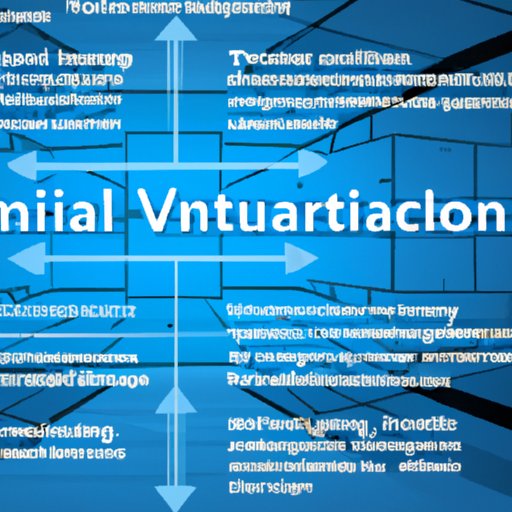Introduction
Virtualization technology is a rapidly developing field that has revolutionized the way businesses operate. By allowing users to create virtual versions of physical resources, such as servers, storage, and networking equipment, virtualization technologies enable businesses to optimize their operations and reduce costs. This article will explore what virtualization technologies are, how they differ from traditional computing, and the impact they have had on businesses.
Explaining the Basics of Virtualization Technologies
Before delving into the specifics of virtualization technologies, it is important to understand what virtualization is. In a nutshell, virtualization is the process of creating a virtual version of a physical resource. This virtual resource can then be used to run applications, store data, or provide access to other resources. By creating a virtual environment, companies can save time and money by eliminating the need to purchase, install, and maintain physical hardware.
There are numerous benefits and advantages associated with virtualization technologies. One of the most significant is improved scalability. With a virtual environment, companies can quickly and easily scale up or down depending on their needs. Additionally, virtualization technologies allow businesses to take advantage of cloud computing and other advanced technologies, such as software-defined networking (SDN). Finally, virtualization technologies offer enhanced security features, such as encryption and multi-factor authentication.
Analyzing Different Types of Virtualization Technologies
Virtualization technologies come in many forms, each of which offers its own unique set of benefits. The most common types of virtualization technologies include server virtualization, desktop virtualization, application virtualization, and network virtualization.
Server Virtualization – Server virtualization involves creating a virtual version of a physical server. This allows multiple operating systems and applications to be run on one server, reducing the cost and complexity of managing multiple physical servers. Additionally, server virtualization provides greater flexibility, allowing companies to quickly and easily spin up new servers as needed.
Desktop Virtualization – Desktop virtualization enables companies to create virtual desktops that can be accessed remotely. This eliminates the need to manage and maintain physical desktops, while providing employees with secure access to their workstations from any location.
Application Virtualization – Application virtualization enables companies to package and deploy applications without having to install them on each individual device. This reduces the cost and complexity associated with deploying applications, while also ensuring that applications are always up to date.
Network Virtualization – Network virtualization allows companies to create virtual networks that can be accessed from anywhere. This allows businesses to securely connect remote offices, branch locations, and mobile users without having to invest in physical hardware.

Comparing Virtualization Technologies to Traditional Computing
When compared to traditional computing, virtualization technologies offer numerous performance gains. For example, virtualized applications typically run faster than their non-virtualized counterparts, due to the fact that they are not constrained by the underlying hardware. Additionally, virtualized environments require fewer resources, resulting in lower energy costs and reduced maintenance costs.
In addition to performance gains, virtualization technologies offer significant cost savings. According to a recent study by Gartner, server virtualization has enabled businesses to reduce their IT costs by up to 30 percent. Furthermore, virtualization technologies eliminate the need for additional hardware, such as servers, storage, and networking equipment, resulting in even greater cost savings.

Examining the Impact of Virtualization on Businesses
The impact of virtualization technologies on businesses has been profound. By enabling businesses to optimize their operations, virtualization technologies have significantly increased efficiency and scalability. Additionally, virtualization technologies have improved security by providing enhanced encryption and authentication methods.
One of the most significant impacts of virtualization technologies is that they have enabled businesses to become more agile and responsive to changing market conditions. By leveraging virtualization technologies, businesses can quickly spin up new resources as needed, allowing them to respond quickly to customer demands and market opportunities.
Discussing the Security Implications of Virtualization Technologies
Despite the numerous benefits of virtualization technologies, there are also potential security risks. Because virtual environments are often shared between multiple users, there is an increased risk of data leakage and unauthorized access. Additionally, virtualized environments can be vulnerable to malicious attacks, such as malware and ransomware.
To ensure the security of a virtual environment, businesses must implement best practices for securing their virtual infrastructure. This includes using strong passwords, implementing firewalls, and using antivirus software. Additionally, businesses should consider using encryption technologies, such as HTTPS, to protect sensitive data.

Exploring the Future of Virtualization Technologies
As virtualization technologies continue to evolve, there are several trends that are likely to shape the future of the industry. One of the most significant trends is the increasing use of containers. Containers are lightweight virtual environments that enable businesses to quickly and easily deploy applications without having to install them on each individual device.
Another trend that is likely to shape the future of virtualization technologies is the use of artificial intelligence (AI). AI-enabled virtualization technologies can automate the deployment and management of virtual environments, enabling businesses to optimize their operations and reduce costs.
Finally, the rise of 5G networks is likely to spur further innovation in the virtualization space. 5G networks will provide businesses with faster speeds and lower latency, enabling them to take full advantage of virtualization technologies.
Conclusion
Virtualization technologies have revolutionized the way businesses operate, enabling them to optimize their operations, reduce costs, and increase efficiency. While virtualization technologies offer numerous benefits, businesses must also be aware of the potential security risks associated with virtual environments. As virtualization technologies continue to evolve, businesses must stay informed of the latest trends and best practices in order to remain competitive.
(Note: Is this article not meeting your expectations? Do you have knowledge or insights to share? Unlock new opportunities and expand your reach by joining our authors team. Click Registration to join us and share your expertise with our readers.)
